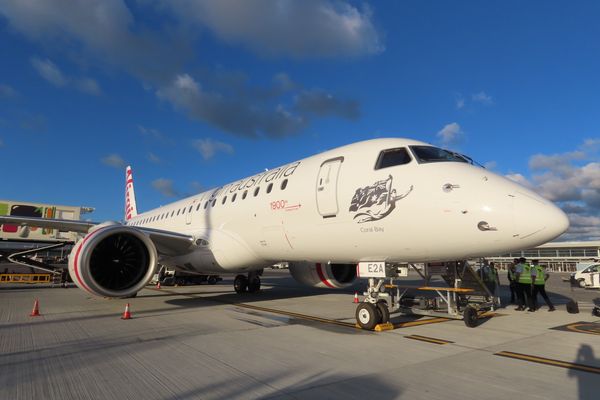Delta Air Lines has been working with a UK-based consortium known as Air4All to develop new wheelchair seats onboard planes themselves for accessibility. The wheelchair may drastically change the lives of many disabled people, although not immediately.

The Hassle of the Disabled
Air travel difficulties for passengers who use wheelchairs have become an increasingly publicized issue, with passengers complaining about their mobility products being damaged in cargo holds or lost, causing massive disruptions for those travelers. The process of boarding itself can be quite a hassle as well.
Currently, powered wheelchair users must use wheelchairs supplied by the airline when traversing the airport and boarding aircraft. After being transferred from multiple chairs, they are transferred one last time into their seat on the aircraft itself.
Their personal wheelchair is then put into the cargo hold. Many instances of carriers damaging and sometimes breaking mobility devices en route to the cargo hold have occurred, many of which have been tailored specifically and have cost thousands of dollars.

In 2022 alone, 11,389 wheelchairs were mishandled by US-based airlines, according to the US Department of Transportation's 2023 February Air Travel Consumer Report. Because of these risks, Delta and Air4All instead want to prevent damage by having the passenger's personal wheelchair be the seat on the aircraft. This way, passengers with reduced mobility never have to leave their seat for the entire journey, whether it be in the aircraft or airport.
Positive Impacts
The prototype was designed by Air4All, a United-Kingdom-based consortium, in partnership with Delta Flight Products (DFP), a subsidiary of the airline that designs and creates cabin interiors for not just Delta, but other airlines as well.
The seat prototype, which was shown at the Aircraft Interiors Expo this week in Hamburg Germany, could allow passengers with powered wheelchairs to bring them into the cabin and use them during the flight, rather than go through the hassle of having to check the wheelchair and be pushed by a second person onto the plane. If the new seat were to make it onto a commercial aircraft, it could be the first of its kind.
Potential Flaws
Delta has stressed that the solution is still early in the design process, and could require at least 18 more months of development and certification work. There is also the possibility that the seat never reaches the market, as new seat designs are often displayed at events similar to the Aircraft Interiors Expo yet never appear on aircraft. This could be due to reasons such as safety regulations, or limited practical use.

Even if the seat were eventually certified, there is no guarantee that Delta itself would use the chair on its own aircraft due to various reasons. Instead, the airline may make the seat available to other carriers through the DFP subsidiary.
A huge difficulty airlines could face would be if the seat itself was not compatible with a majority of wheelchairs due to how specifically they are tailored. This could limit the use of the seat and force carriers to leave space on the aircraft when not being used.
However, Air4All's website suggests converting the seat into a standard seat for passenger use when not being used by those requiring wheelchairs.
Maiden Brazil: Virgin Australia Welcomes the Iconic Embraer E2 » China Eastern Inaugurates New World's Longest Flight »
Comments (0)
Add Your Comment
SHARE
TAGS
NEWS Delta Mobility Wheelchairs Passenger Assistance Air4All DSP Delta Air Lines Mishandling CargoRECENTLY PUBLISHED
 Maiden Brazil: Virgin Australia Welcomes the Iconic Embraer E2
Known for its aging intrastate fleets and unmatched concentration of Fokker 100s, Perth Airport has been a time capsule for aviation enthusiasts. Now, Virgin Australia Regional Airlines is breaking tradition with the arrival of the cutting-edge Embraer E190-E2, ushering in a new era for Western Australian air travel.
TRIP REPORTS
READ MORE »
Maiden Brazil: Virgin Australia Welcomes the Iconic Embraer E2
Known for its aging intrastate fleets and unmatched concentration of Fokker 100s, Perth Airport has been a time capsule for aviation enthusiasts. Now, Virgin Australia Regional Airlines is breaking tradition with the arrival of the cutting-edge Embraer E190-E2, ushering in a new era for Western Australian air travel.
TRIP REPORTS
READ MORE »
 China Eastern Inaugurates New World's Longest Flight
China Eastern recently launched its longest flight, a route connecting Shanghai and Buenos Aires via a stopover in Auckland. Inaugurated in December, this was advertised as a “Direct Air Link” between Asia and South America.
ROUTES
READ MORE »
China Eastern Inaugurates New World's Longest Flight
China Eastern recently launched its longest flight, a route connecting Shanghai and Buenos Aires via a stopover in Auckland. Inaugurated in December, this was advertised as a “Direct Air Link” between Asia and South America.
ROUTES
READ MORE »
 Essential Legal Tips for Tourists Chartering a Yacht in Dubai
Discover how yacht rentals in Dubai are regulated and learn what every tourist should know about contracts, insurance, and taxes before setting sail.
TRIP REPORTS
READ MORE »
Essential Legal Tips for Tourists Chartering a Yacht in Dubai
Discover how yacht rentals in Dubai are regulated and learn what every tourist should know about contracts, insurance, and taxes before setting sail.
TRIP REPORTS
READ MORE »



